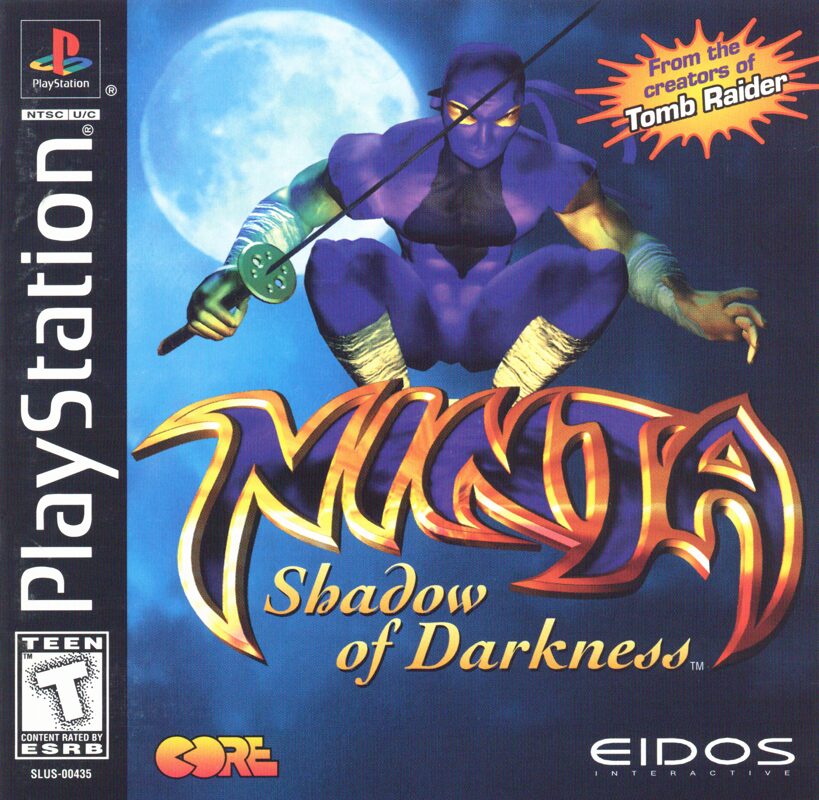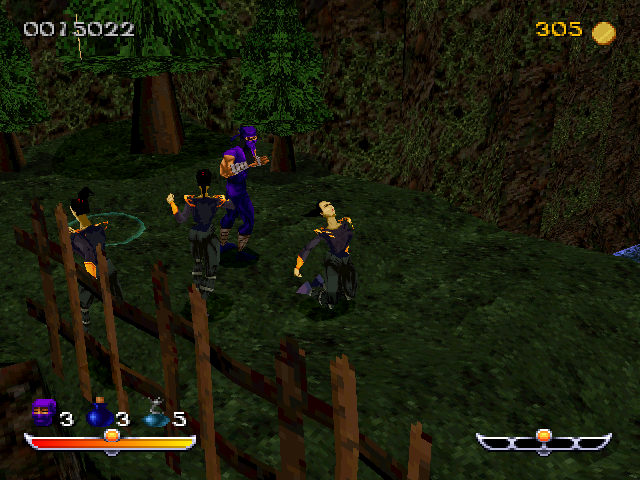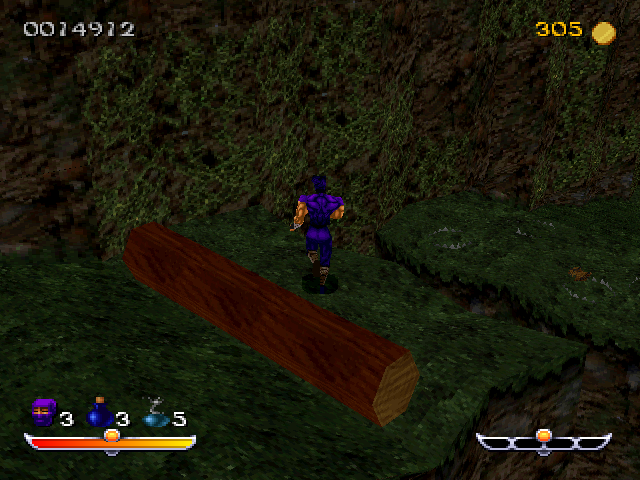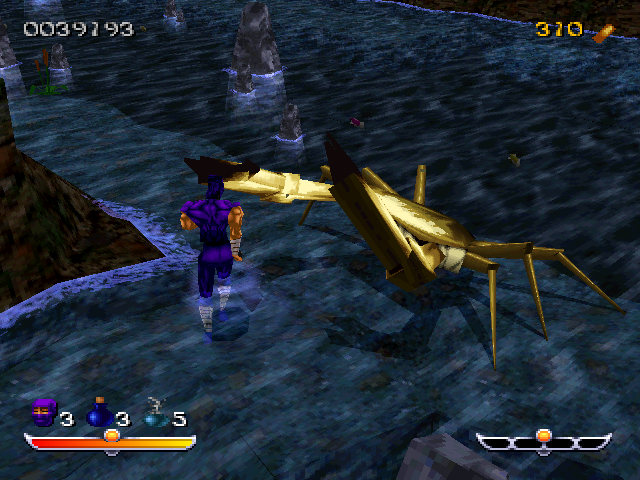Retro Replay Review
Gameplay
Ninja: Shadow of Darkness places you in the tabi shoes of Kurosawa, a young ninja on a mission to save his homeland from a demonic invasion. The core of the game is its third-person action arcade combat, where you navigate through 11 distinct levels packed with puzzles, standard foes, and challenging bosses. Kurosawa’s repertoire includes dozens of fighting moves—ranging from swift sword slashes to aerial combos—and an arsenal of weapons such as shuriken, kunai, and specialized blades. You’ll also unlock magic spells that let you rain fireballs or summon lightning to turn the tide against swarms of enemies.
Combat feels weighty and purposeful, but can sometimes border on repetitive once you’ve mastered the core combo loops. Enemy AI is straightforward—melee brutes charge headlong into your weapons while ranged attackers pepper you with projectiles—but bosses often require you to learn attack patterns and time your counters precisely. The game keeps things interesting by mixing in environmental hazards, levers that open secret areas, and timed platforming segments that test your reflexes as well as your combat skills.
Platforming elements shine in certain levels, where narrow ledges, disappearing platforms, and moving walls force you to think like a ninja. Precision jumps are required to reach secret weapon caches or hidden health pickups, giving exploration-minded players extra incentive to scour every crevice. The puzzle sections—often involving pressure plates, rotating pillars, or sliding blocks—add a welcome break from nonstop fighting, though they rarely present anything more than moderate brain-teasers.
Controls are generally responsive, with the PlayStation port showing slight delay compared to the Saturn original but never enough to frustrate aggressively. Lock-on targeting helps in crowded skirmishes, and the ability to switch on-the-fly between melee weapons or spells keeps your strategy flexible. A stamina meter for special attacks ensures you can’t spam your most powerful moves, adding a layer of resource management that dovetails nicely with the game’s arcade roots.
Graphics
For its era, Ninja: Shadow of Darkness delivers crisp visuals that lean into the moody, gothic aesthetic of feudal Japan under siege. Character models are built from relatively low polygon counts, yet detail is ample: you can see the swirling folds of Kurosawa’s robe and the glint of enemy armor as fight scenes unfold. Environmental textures vary from mossy temple walls to smoldering rooftops, creating an immersive backdrop for your ninja exploits.
The transition from Sega Saturn to PlayStation resulted in smoother frame rates on Sony’s hardware, but you may notice occasional texture pop-in or clipping at a distance. Shadows are handled via simple projected shapes rather than dynamic lighting, which can make darker levels look a bit washed out. Nevertheless, atmospheric effects—like drifting embers in lava chambers or rain-slicked courtyard battles—add a cinematic flair that complements the game’s tone.
Cutscenes are rendered in-engine, which lends a cohesive look to storytelling and gameplay alike. While these sequences employ limited camera angles, the camera work does a fine job of highlighting key action moments: boss introductions, dramatic entrances, and triumphant finishing moves. Character animations are fluid for standard attacks, but transitions into spells or weapon swaps can feel slightly robotic, a common limitation of the period’s 3D engines.
Overall, the art direction strikes a balance between realism and stylized fantasy. Color palettes shift from muted grays and browns in foreboding temples to vivid reds and purples in demon-infested strongholds. Although the visuals haven’t aged like a high-budget console title, they remain evocative enough that new players can appreciate the design choices without feeling too distracted by technological limitations.
Story
The narrative of Ninja: Shadow of Darkness unfolds in a mythical land besieged by dark forces, with Kurosawa as the reluctant hero drawn from his village to combat the threat. Early cutscenes establish a sense of urgency: villagers vanish overnight, temples burn, and rumors swirl of a powerful demon lord orchestrating the chaos. As you progress, brief interludes reveal more about Kurosawa’s past—his rigorous training under a master sensei and the mysterious destiny that ties him to the supernatural invaders.
Story beats are delivered primarily through on-screen text and still-image panels, which may feel sparse by modern standards. However, the game peppers in environmental storytelling—ruined statues, blood-stained altars, and cryptic glyphs—so that exploration often yields additional lore tidbits. NPC encounters are rare and almost always combat-oriented, reinforcing the arcade-style pace but limiting deeper character interactions.
Boss battles serve as climactic narrative checkpoints, each overseen by a lieutenant of the demon army. These villains—from a giant armored samurai to a winged oni sorcerer—are introduced with intimidating visuals and short text blurbs that convey their motivations. Defeating them gradually uncovers the master villain’s identity, culminating in a final showdown that ties together the magical and martial threads of Kurosawa’s journey.
While the storyline lacks branching paths or moral choices, it maintains a steady momentum that keeps you motivated to push through all 11 levels. The blend of ninjutsu tradition, arcane spellcraft, and demon-hunting tropes may not break new narrative ground, but it provides a solid framework that justifies the game’s diverse environments and escalating difficulty.
Overall Experience
Ninja: Shadow of Darkness offers a robust action-arcade adventure that will appeal to fans of classic 3D beat ’em ups and platformers. Its blend of melee combat, magic spells, and light puzzle-solving maintains engagement across 11 varied levels, each culminating in a boss fight that tests your mastery of the game’s mechanics. Newcomers to retro gaming should be prepared for a challenge, but most will find the learning curve fair and rewarding.
Sound design is a highlight, with an energetic soundtrack that fuses traditional Japanese instrumentation and driving percussive beats. SFX—like the metallic hiss of blades or the crackle of lightning spells—are satisfyingly punchy, even through modern TV speakers. Voice snippets are used sparingly, and though the quality is modest, they underscore key moments without overshadowing the game’s arcade focus.
The balance of combat and platforming ensures that boredom rarely sets in, though repetition can creep in if you favor a single weapon or spell too long. Replay value comes from seeking hidden areas, perfecting boss strategies, and challenging yourself to clear levels without taking damage. There’s also a nostalgic charm in revisiting a title that bridged two 32-bit console generations, showcasing both the best and limits of early polygonal action games.
In conclusion, Ninja: Shadow of Darkness may not boast the technical polish of today’s blockbusters, but its earnest design, varied gameplay, and atmospheric presentation make it a worthy addition to any retro action enthusiast’s library. Whether you’re drawn to intricate combat combos, demon-slaying exploits, or simply exploring moody, mystical realms, Kurosawa’s journey delivers a satisfying arcade romp that stands the test of time.
 Retro Replay Retro Replay gaming reviews, news, emulation, geek stuff and more!
Retro Replay Retro Replay gaming reviews, news, emulation, geek stuff and more!









Reviews
There are no reviews yet.